Isaac Caswell
WMT24++: Expanding the Language Coverage of WMT24 to 55 Languages & Dialects
Feb 18, 2025Abstract:As large language models (LLM) become more and more capable in languages other than English, it is important to collect benchmark datasets in order to evaluate their multilingual performance, including on tasks like machine translation (MT). In this work, we extend the WMT24 dataset to cover 55 languages by collecting new human-written references and post-edits for 46 new languages and dialects in addition to post-edits of the references in 8 out of 9 languages in the original WMT24 dataset. The dataset covers four domains: literary, news, social, and speech. We benchmark a variety of MT providers and LLMs on the collected dataset using automatic metrics and find that LLMs are the best-performing MT systems in all 55 languages. These results should be confirmed using a human-based evaluation, which we leave for future work.
SMOL: Professionally translated parallel data for 115 under-represented languages
Feb 17, 2025Abstract:We open-source SMOL (Set of Maximal Overall Leverage), a suite of training data to unlock translation for low-resource languages (LRLs). SMOL has been translated into 115 under-resourced languages, including many for which there exist no previous public resources, for a total of 6.1M translated tokens. SMOL comprises two sub-datasets, each carefully chosen for maximum impact given its size: SMOL-Sent, a set of sentences chosen for broad unique token coverage, and SMOL-Doc, a document-level source focusing on a broad topic coverage. They join the already released GATITOS for a trifecta of paragraph, sentence, and token-level content. We demonstrate that using SMOL to prompt or fine-tune Large Language Models yields robust ChrF improvements. In addition to translation, we provide factuality ratings and rationales for all documents in SMOL-Doc, yielding the first factuality datasets for most of these languages.
Separating the Wheat from the Chaff with BREAD: An open-source benchmark and metrics to detect redundancy in text
Nov 11, 2023Abstract:Data quality is a problem that perpetually resurfaces throughout the field of NLP, regardless of task, domain, or architecture, and remains especially severe for lower-resource languages. A typical and insidious issue, affecting both training data and model output, is data that is repetitive and dominated by linguistically uninteresting boilerplate, such as price catalogs or computer-generated log files. Though this problem permeates many web-scraped corpora, there has yet to be a benchmark to test against, or a systematic study to find simple metrics that generalize across languages and agree with human judgements of data quality. In the present work, we create and release BREAD, a human-labeled benchmark on repetitive boilerplate vs. plausible linguistic content, spanning 360 languages. We release several baseline CRED (Character REDundancy) scores along with it, and evaluate their effectiveness on BREAD. We hope that the community will use this resource to develop better filtering methods, and that our reference implementations of CRED scores can become standard corpus evaluation tools, driving the development of cleaner language modeling corpora, especially in low-resource languages.
MADLAD-400: A Multilingual And Document-Level Large Audited Dataset
Sep 09, 2023Abstract:We introduce MADLAD-400, a manually audited, general domain 3T token monolingual dataset based on CommonCrawl, spanning 419 languages. We discuss the limitations revealed by self-auditing MADLAD-400, and the role data auditing had in the dataset creation process. We then train and release a 10.7B-parameter multilingual machine translation model on 250 billion tokens covering over 450 languages using publicly available data, and find that it is competitive with models that are significantly larger, and report the results on different domains. In addition, we train a 8B-parameter language model, and assess the results on few-shot translation. We make the baseline models available to the research community.
XTREME-UP: A User-Centric Scarce-Data Benchmark for Under-Represented Languages
May 24, 2023



Abstract:Data scarcity is a crucial issue for the development of highly multilingual NLP systems. Yet for many under-represented languages (ULs) -- languages for which NLP re-search is particularly far behind in meeting user needs -- it is feasible to annotate small amounts of data. Motivated by this, we propose XTREME-UP, a benchmark defined by: its focus on the scarce-data scenario rather than zero-shot; its focus on user-centric tasks -- tasks with broad adoption by speakers of high-resource languages; and its focus on under-represented languages where this scarce-data scenario tends to be most realistic. XTREME-UP evaluates the capabilities of language models across 88 under-represented languages over 9 key user-centric technologies including ASR, OCR, MT, and information access tasks that are of general utility. We create new datasets for OCR, autocomplete, semantic parsing, and transliteration, and build on and refine existing datasets for other tasks. XTREME-UP provides methodology for evaluating many modeling scenarios including text-only, multi-modal (vision, audio, and text),supervised parameter tuning, and in-context learning. We evaluate commonly used models on the benchmark. We release all code and scripts to train and evaluate models
Bilex Rx: Lexical Data Augmentation for Massively Multilingual Machine Translation
Mar 27, 2023Abstract:Neural machine translation (NMT) has progressed rapidly over the past several years, and modern models are able to achieve relatively high quality using only monolingual text data, an approach dubbed Unsupervised Machine Translation (UNMT). However, these models still struggle in a variety of ways, including aspects of translation that for a human are the easiest - for instance, correctly translating common nouns. This work explores a cheap and abundant resource to combat this problem: bilingual lexica. We test the efficacy of bilingual lexica in a real-world set-up, on 200-language translation models trained on web-crawled text. We present several findings: (1) using lexical data augmentation, we demonstrate sizable performance gains for unsupervised translation; (2) we compare several families of data augmentation, demonstrating that they yield similar improvements, and can be combined for even greater improvements; (3) we demonstrate the importance of carefully curated lexica over larger, noisier ones, especially with larger models; and (4) we compare the efficacy of multilingual lexicon data versus human-translated parallel data. Finally, we open-source GATITOS (available at https://github.com/google-research/url-nlp/tree/main/gatitos), a new multilingual lexicon for 26 low-resource languages, which had the highest performance among lexica in our experiments.
Building Machine Translation Systems for the Next Thousand Languages
May 16, 2022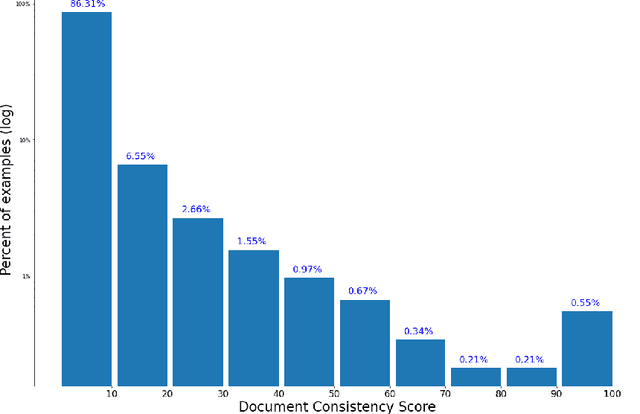


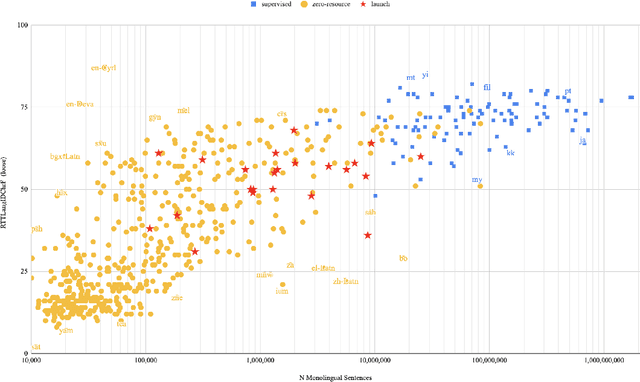
Abstract:In this paper we share findings from our effort to build practical machine translation (MT) systems capable of translating across over one thousand languages. We describe results in three research domains: (i) Building clean, web-mined datasets for 1500+ languages by leveraging semi-supervised pre-training for language identification and developing data-driven filtering techniques; (ii) Developing practical MT models for under-served languages by leveraging massively multilingual models trained with supervised parallel data for over 100 high-resource languages and monolingual datasets for an additional 1000+ languages; and (iii) Studying the limitations of evaluation metrics for these languages and conducting qualitative analysis of the outputs from our MT models, highlighting several frequent error modes of these types of models. We hope that our work provides useful insights to practitioners working towards building MT systems for currently understudied languages, and highlights research directions that can complement the weaknesses of massively multilingual models in data-sparse settings.
Towards the Next 1000 Languages in Multilingual Machine Translation: Exploring the Synergy Between Supervised and Self-Supervised Learning
Jan 13, 2022



Abstract:Achieving universal translation between all human language pairs is the holy-grail of machine translation (MT) research. While recent progress in massively multilingual MT is one step closer to reaching this goal, it is becoming evident that extending a multilingual MT system simply by training on more parallel data is unscalable, since the availability of labeled data for low-resource and non-English-centric language pairs is forbiddingly limited. To this end, we present a pragmatic approach towards building a multilingual MT model that covers hundreds of languages, using a mixture of supervised and self-supervised objectives, depending on the data availability for different language pairs. We demonstrate that the synergy between these two training paradigms enables the model to produce high-quality translations in the zero-resource setting, even surpassing supervised translation quality for low- and mid-resource languages. We conduct a wide array of experiments to understand the effect of the degree of multilingual supervision, domain mismatches and amounts of parallel and monolingual data on the quality of our self-supervised multilingual models. To demonstrate the scalability of the approach, we train models with over 200 languages and demonstrate high performance on zero-resource translation on several previously under-studied languages. We hope our findings will serve as a stepping stone towards enabling translation for the next thousand languages.
Quality at a Glance: An Audit of Web-Crawled Multilingual Datasets
Mar 22, 2021
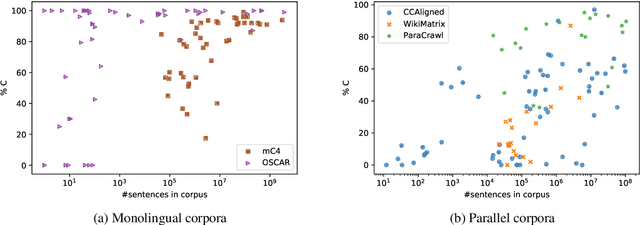
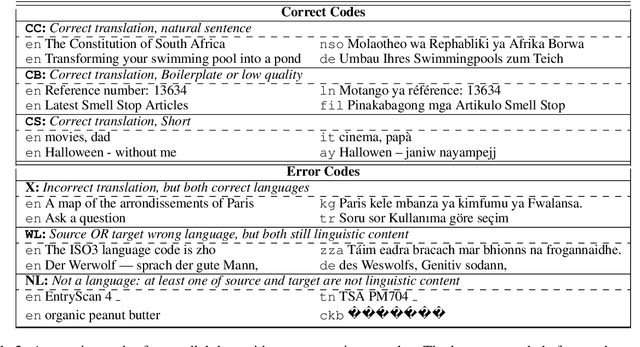
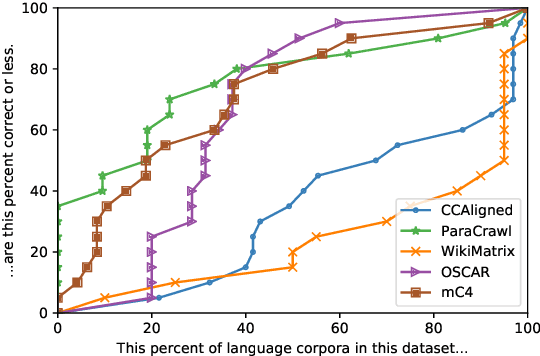
Abstract:With the success of large-scale pre-training and multilingual modeling in Natural Language Processing (NLP), recent years have seen a proliferation of large, web-mined text datasets covering hundreds of languages. However, to date there has been no systematic analysis of the quality of these publicly available datasets, or whether the datasets actually contain content in the languages they claim to represent. In this work, we manually audit the quality of 205 language-specific corpora released with five major public datasets (CCAligned, ParaCrawl, WikiMatrix, OSCAR, mC4), and audit the correctness of language codes in a sixth (JW300). We find that lower-resource corpora have systematic issues: at least 15 corpora are completely erroneous, and a significant fraction contains less than 50% sentences of acceptable quality. Similarly, we find 82 corpora that are mislabeled or use nonstandard/ambiguous language codes. We demonstrate that these issues are easy to detect even for non-speakers of the languages in question, and supplement the human judgements with automatic analyses. Inspired by our analysis, we recommend techniques to evaluate and improve multilingual corpora and discuss the risks that come with low-quality data releases.
Language ID in the Wild: Unexpected Challenges on the Path to a Thousand-Language Web Text Corpus
Oct 29, 2020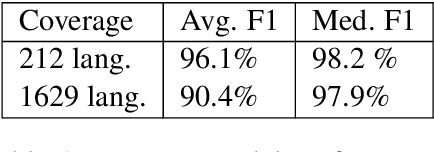

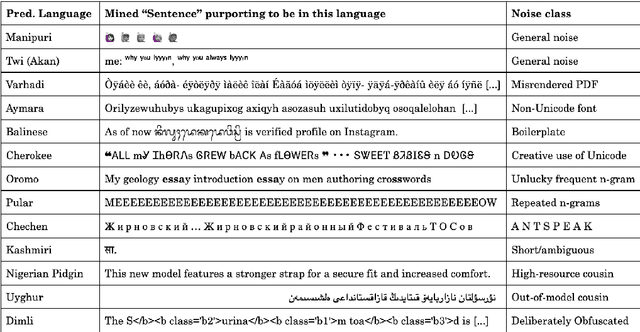
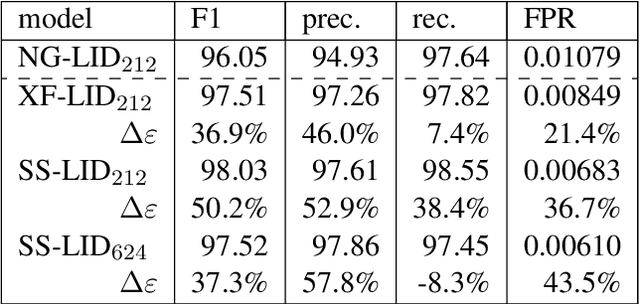
Abstract:Large text corpora are increasingly important for a wide variety of Natural Language Processing (NLP) tasks, and automatic language identification (LangID) is a core technology needed to collect such datasets in a multilingual context. LangID is largely treated as solved in the literature, with models reported that achieve over 90% average F1 on as many as 1,366 languages. We train LangID models on up to 1,629 languages with comparable quality on held-out test sets, but find that human-judged LangID accuracy for web-crawl text corpora created using these models is only around 5% for many lower-resource languages, suggesting a need for more robust evaluation. Further analysis revealed a variety of error modes, arising from domain mismatch, class imbalance, language similarity, and insufficiently expressive models. We propose two classes of techniques to mitigate these errors: wordlist-based tunable-precision filters (for which we release curated lists in about 500 languages) and transformer-based semi-supervised LangID models, which increase median dataset precision from 5.5% to 71.2%. These techniques enable us to create an initial data set covering 100K or more relatively clean sentences in each of 500+ languages, paving the way towards a 1,000-language web text corpus.
 Add to Chrome
Add to Chrome Add to Firefox
Add to Firefox Add to Edge
Add to Edge